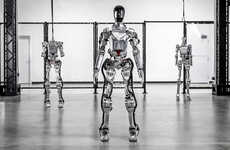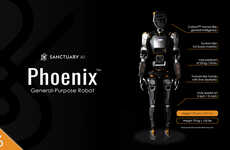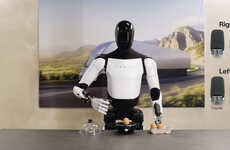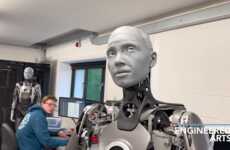
Boston Dynamics' Atlas is Touted as "The World's Most Dynamic Humanoid"
Laura McQuarrie — May 16, 2018 — Tech
References: bostondynamics & 3dprint
Boston Dynamics' Atlas project has been in development for a few years now and the incredible movements that the robot is capable of were recently shared in a video from the American engineering and robotics design company.
In the video, the humanoid robot can be seen running up hills and jumping over obstacles, which would severely impede other kinds of robots—but the bot sets itself apart with the ability to balance and use whole-body skills.
3D printing played a large part in the development of the Atlas robot, particularly when it came to developing its lightweight yet strong form. The robot has 28 joints, stereo vision and even the ability to lift 11 kilograms; as such, it's hardly any wonder that Boston Dynamics' Atlas is called "the world's most dynamic humanoid."
In the video, the humanoid robot can be seen running up hills and jumping over obstacles, which would severely impede other kinds of robots—but the bot sets itself apart with the ability to balance and use whole-body skills.
3D printing played a large part in the development of the Atlas robot, particularly when it came to developing its lightweight yet strong form. The robot has 28 joints, stereo vision and even the ability to lift 11 kilograms; as such, it's hardly any wonder that Boston Dynamics' Atlas is called "the world's most dynamic humanoid."
Trend Themes
1. Agile Humanoid Robots - The development of Atlas showcases the potential for agile humanoid robots with the ability to run, jump, balance, and use whole-body skills.
2. 3D Printing in Robotics - The use of 3D printing in developing lightweight yet strong forms for robots like Atlas opens up disruptive innovation opportunities in the robotics industry.
3. Advanced Robot Vision - The stereo vision capabilities of Atlas demonstrate the importance of advanced robot vision technologies for improved perception and decision-making in various industries.
Industry Implications
1. Robotics - The agile capabilities of Atlas highlight disruptive innovation opportunities in the robotics industry, particularly in areas such as automation, logistics, and healthcare.
2. Manufacturing - The use of 3D printing in robot development presents disruptive innovation opportunities in the manufacturing industry for creating lightweight and customizable robotic solutions.
3. Artificial Intelligence - The advanced vision capabilities of humanoid robots like Atlas drive disruptive innovation opportunities in the artificial intelligence industry, enabling robots to better perceive and interact with the world.
2.3
Score
Popularity
Activity
Freshness















